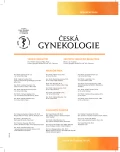Prenatally diagnosed patent urachus with umbilical cord cyst and early surgical intervention
Authors:
R. Blažík 1; J. Matěcha 2; M. Pýchová 3; E. Bayerová 4; Roman Chmel 2; Michal Černý 1; Tomáš Fait 2
Authors‘ workplace:
Novorozenecké oddělení s JIRP Gynekologicko-porodnické kliniky 2. LF UK a FN Motol, Praha, primář MUDr. M. Černý
1; Gynekologicko-porodnická klinika 2. LF UK a FN Motol, Praha, přednosta MUDr. R. Chmel, Ph. D., MHA
2; Klinika dětské chirurgie 2. LF UK a FN Motol, Praha, přednosta prof. MUDr. M. Rygl, PhD.
3; Gynekologická ambulance Kallabova, Brno-Žabovřesky
4
Published in:
Ceska Gynekol 2019; 84(6): 425-429
Category:
Case Report
Overview
Objective: Description of rare diagnosis of patent urachus.
Design: Case report.
Setting: Department of Obstetrics and Gynecology, 2nd Faculty of Medicine and Faculty Hospital Motol Prague.
Case report: Patent urachus is a rare diagnosis, which in this case was detected prenatally by ultrasound. Involution of the urachus is not fully completed upon birth, therefore in cases of small persisting communication between the urinary bladder and the umbilicus conservative approach and waiting for spontaneous closure is usually chosen. In our case surgery treatment has chosen as a prevention of urinary infection because of patent urachus manifested as a wide communication.
Conclusion: This congenital defect usually manifests itself early after birth as a visible structural anomaly of the umbilicus and/or as urine leakage in the umbilicus opening area. It is important to keep in mind that urachus irregularities may be accompanied by other urinary system defects. Every child presenting with such an anomaly should therefore be thoroughly examined. If the procedure is performed by an experienced surgical team postoperative complications are uncommon and overall long-term prognosis for patients is excellent.
Keywords:
patent urachus – umbilical cord cyst
Sources
1. Blichert-Toft, M., Nielsen, OV. A congenital patent urachus and acquired variants. Acta Chir Scand, 1971, 137, p. 807–814.
2. Eble, JN., Hull, MT., Rowland, RG., Hostetter, M. Villous adenoma of the urachus with mucusuria: a light and electron microscopic study. J Urol, 1986, 135, p. 1240–1244.
3. Kadian, SY., Rattan, KN., Parihar, D. Urachal anomalies in children. J Surg, 2013, 2(2), p. 51–55.
4. Moore, KL. The urogenital system. In: The developing human, 3rd ed. Philadelphia: Saunders, 1982, p. 255–297.
5. Rich, RH., Hardy, BE., Filler, RM. Surgery for anomalies of the urachus. J Pediatr Surg, 1983, 18, p. 370–372.
6. Rubin, A. A Handbook of Congenital Malformations. Philadelphia: Saunders; 1967.
7. Spataro, RF., Davis, RS., McLachlan, MSF., et al. Urachal abnormalities in the adults. Radiology, 1983, 149, p. 659–663.
8. Ueno, T., Hashimoto, H., Yokoyama, H., et al. Urachal anomalies: ultrasonography and management. J Pediatr Surg, 2003, 38, p. 120.
Labels
Paediatric gynaecology Gynaecology and obstetrics Reproduction medicineArticle was published in
Czech Gynaecology

2019 Issue 6
Most read in this issue
- Histopathological and clinical features of molar pregnancy
- Prenatally diagnosed patent urachus with umbilical cord cyst and early surgical intervention
- The incidence of gestational diabetes mellitus before and after the introduction of HAPO diagnostic criteria
- The effect of physiotherapy intervention on the load of the foot and low back pain in pregnancy
